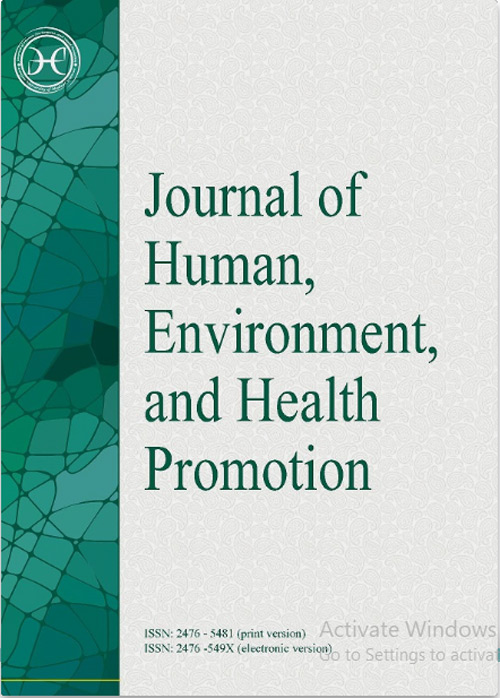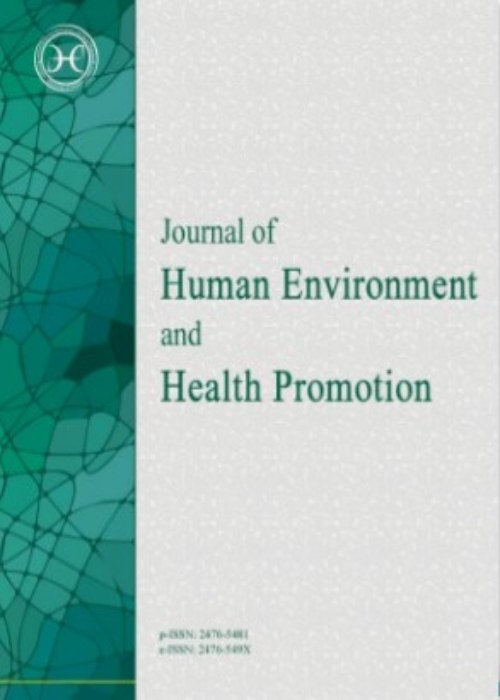فهرست مطالب

Journal of Human Environment and Health Promotion
Volume:5 Issue: 2, Spring 2019
- تاریخ انتشار: 1398/07/10
- تعداد عناوین: 8
-
-
Pages 50-55BackgroundThe present study aimed to replace the integrated sound level meter by the noise map of a work environment in order to estimate the equivalent continuous sound level (Leq) as an important quantity in the noise monitoring of continuous noise sources.MethodsIn this theoretical-experimental study, the grid method was initially used. Sound pressure level (SPL) was measured at the selected stations in three noisy industrial halls. Data analysis was performed in ArcGIS 10.2 software, and the noise map was plotted for each hall separately. Afterwards, the different zones with various SPL intervals were calculated on each noise map, and Leq was determined. For the comparisons, Leq was also calculated using logarithmic equations, based on which the integrated sound level meters were programmed.ResultsThe proposed method was highly accurate with the relative error of less than 2%. Furthermore, it decreased the number of mathematical operations 7-15 times compared to the conventional logarithmic method.ConclusionAccording to the results, the available GIS-based software could be accurately replaced by the routine Leq measurement hardware to estimate the Leq spatial noise in noisy industrial environments.Keywords: Equivalent sound level (Leq), Noise mapping, Geographic information system (GIS), Noise monitoring, Industrial indoor space
-
Pages 56-60BackgroundRemoval of mineral pollutants from polluted soil is considered to be major environmental concern in the modern era. The present study aimed to investigate the capability of lead uptake and transfer in various organs of Crataegusaronia and Juniperuspolycarposseedlings and determine the effects of lead accumulation on some of the quantitative indices of these plant species.MethodsThree-year-old saplings were exposed to various concentrations of lead (zero, 200, 300, and 400 ppm) (No3)2 in the sprouting period in a completely random project in triplicate. Afterwards, the lead uptake value was measured in various organs of C. aronia and J. polycarpus (roots, stems, and leaves) using an atomic absorption device.ResultsThe analysis of variance indicated that the features of C. aronia and J. polycarpus saplings (e.g., stem length, basal diameter, and root length) were significantly influenced by lead contamination (P < 0.05). Moreover, the saplings of both varieties had high capacity for lead uptake in their roots, stems, and leaves.ConclusionAccording to the results, the seedlings of C. aronia and J. polycarpus could be used as stabilizing varieties for the removal of lead from polluted soil. It is also notable that J. polycarpus is a more effective lead absorbent compared to C. aronia.Keywords: Phytoremediation, Lead, Quantitative Indices, C.aronia, J. polycarpus
-
Pages 61-65BackgroundDrug resistance is a major concern in the treatment of burn wounds. The present study aimed to evaluate the effects of silver crystalline nanofibers on the bacteria isolated from burn wounds at Imam Musa Kazim Hospital in Isfahan, Iran and compare the findings with the samples collected from the skin of healthy adults with standard collection bacteria.MethodsAgicoat nanosilver dressing was used as the antibacterial agent. The antibacterial effects of the silver nanoparticle solution and silver crystalline nanofibers were assessed using the well diffusion method. In addition, the macrodilution method was applied to determine the MIC and MBC of the silver crystalline nanofibers.ResultsNo significant difference was observed in the growth inhibition zone of the silver nanoparticle solution and crystalline nanofibers. Comparison of the effects of silver crystalline nanofibers on wound infection bacteria and healthy skin bacteria (MBC = 0.128 mg/ml) were similar although the effects were more significant than the effects of tetracycline. Moreover, the standard bacterial strains were more sensitive to the nanofibers (MBC= 0.032). The antibacterial properties of the silver crystalline nanofibers reduced after the washing process (10 times; P < 0.001).ConclusionAccording to the results, the silver crystalline nanofibers had significant antibacterial properties on burn wound infection bacteria.Keywords: Crystalline silver nanofibers, Healthy skin, Wound infection, MIC, MBC
-
Pages 66-71BackgroundWith the growing use of bottled water, the continuous research and monitoring of the quality of these products are crucial. The present study aimed to assess the chemical quality of the bottled water distributed in Gorgan, Iran.MethodsThis cross-sectional, descriptive-analytical study was conducted on the samples of bottled water distributed in Gorgan city. Sampling was performed during four months (one sample of each brand obtained every month; total: 36). The chemical quality of the samples was measured using standard methods.ResultsThe mean concentrations of nitrate, fluoride, and iron and mean pH of the samples were 12.92 ± 11.05, 0.33 ± 0.12, and 0.64 ± 2.9 mg/l and 6.89 ± 0.39, respectively. Only the physicochemical parameters of pH and iron were significantly higher than the standard values, and the mean levels of the chemical factors were significantly lower than the standard values (P < 0.05).ConclusionConsumers expect bottled water to have higher quality as they perceive the product to be a healthier choice than the water supplied by urban distribution networks. High levels of some chemical parameters could adversely affect the health of consumers, especially vulnerable populations, which should be taken into consideration by custodians and authorities.Keywords: Bottled water, Chemical quality, Gorgan city
-
Pages 72-78BackgroundYersinia enterocolitica (Y. enterocolitica) has a wide range of clinical, animal, food, and water sources. Most studies have indicated that food is the most common source of this organism. The present study aimed to evaluate the virulent genes of Y. enterocolitica isolated from dairy products in Iran.MethodsThe virulence of Y. enterocolitica biotypes was investigated, which was isolated from 38 cheese and 33 raw milk samples in the northeast of Iran. In total, six virulence-related genes were evaluated, including ail, inv, yadA, myfA, ystA, and ystB in 1A, 1B, and 5 Y. enterocolitica biotypes.ResultsIn the isolates of the 1A biotype, ystB was the most frequent gene (86.95% and 38.46% in cheese and raw milk, respectively). In the 1B biotype, the most frequently isolated gene was yadA (92.30% and 66.66% in cheese and raw milk, respectively). In all the isolates, the least frequently isolated gene was ail, followed by myfA.ConclusionAccording to the results, the presence of virulence genes in the Y. enterocolitica strains isolated from dairy products suggested that these strains could pose significant risk to public health if dispersed in susceptible human population.Keywords: Yersinia enterocolitica, Virulence, Dairy products
-
Pages 79-85BackgroundThe purpose of this study was to determine the effect of rosemary essential oil (REO) nanoemulsion against some important food borne pathogens.MethodsAntibacterial effects of REO and REO nanoemulsion were determined using Agar disc diffusion, Broth microdilution and Steam phase diffusion methods against Staphylococcus aureus, Escherichia coli, Pseudomonas aeruginosa, Shewanella SP, Listeria monocytogenes and Salmonella enteritidis.ResultsAntibacterial effect of REO and REO nanoemulsion was increased with concentration enhancing of REO. There was no significant antibacterial activity in the effectiveness of nanoemulsion on the studied bacteria in comparison with REO in both disk diffusion and steam phase diffusion methods. MIC and MBC analysis of REO and prepared REO nanoemulsion showed that REO and its nanoemulsion have inhibited all studied bacteria. REO showed better inhibitory effects. REO and nanoemulsion of rosemary essential oil have the greatest effect on Shewanella SP., L. monocytogenes, S. aureus, S.enteritidis, E. coli and P. aeruginosa, respectively.ConclusionIn total, it can be said that REO and its nanoemulsion are desirable to inhibit the growth of food borne pathogens and can be a good choice as antimicrobial agents in food industry to enhance safety and extend foods’ shelf life.Keywords: Agar disk diffusion test, Broth microdilution method, Nanoemulsion, Rosemary essential oil, Steam phase diffusion method
-
Pages 86-93BackgroundThe Study aimed to investigate the chemical composition, antimicrobial effects, and antioxidant properties of clove and lemon verbena essential oils (EOs).MethodsThe chemical composition of the EOs was identified using gas chromatography/mass spectrometry (GC/MS). In addition, the antibacterial effects of EOs against seven important foodborne bacteria were assessed using the disk-diffusion, agar well-diffusion, and broth microdilution assays. Evaluation of the antioxidant properties of the EOs was carried out using DPPH, β-carotene-linoleic acid bleaching, and reducing power assay.ResultsAll the tested bacteria demonstrated susceptibility to EOs, with the highest susceptibility observed in Bacillus cereus to the clove EO in the agar disk-diffusion test. Moreover, Shigella dysenteriae was identified as the most sensitive bacterium to the lemon verbena EO. Salmonella typhimurium was the most resistant bacterium to both EOs. In the agar well-diffusion test, Pseudomonas aeruginosa and S. typhimurium had the lowest sensitivity to the clove and lemon verbena EOs, respectively. Although both EOs exhibited significant antioxidant capacity, the lemon verbena EO showed higher antioxidant activity in all the tests, with the exception of β-carotene-linoleic acid bleaching test.ConclusionClove and lemon verbena EOs could be regarded as potential sources of natural antioxidant and antimicrobial agents in food processing.Keywords: Essential oil, Syzgium aromaticum, Aloysia Citriodora, Antioxidant activity, Antimicrobial activity
-
Pages 94-97BackgroundThe present study aimed to determine the chemical composition and in-vitro antibacterial activity of Ziziphora clinopodioides essential oil (ZCEO).MethodsThe chemical composition of ZCEO was determined using gas chromatography-mass spectrometry (GC-MS) analysis. Minimum inhibitory concentration (MIC) and minimum bactericidal concentration (MBC) were calculated using the microwell dilution assay to assess the antibacterial effects of ZCEO emulsion and nano-emulsion on E. coli O157:H7.ResultsA yield of 1% (w/w) was identified for ZCEO isolation and pulegone (58.78%), menthone (1.15%), and isomenthone (9.91%) as the key components of ZCEO phytochemicals. The MIC values of the ZCEO emulsion and nano-emulsion were 0.8 and 0.025 mg/ml, respectively, and the MBC values were estimated at 1.6 and 0.05, respectively.ConclusionIt is recommended that the nano-emulsion of ZCEO be applied as a potential source of natural preservatives in food industries.Keywords: Essential oil, Antibacterial activity, Nanotechnology, Escherichia coli O157:H7


